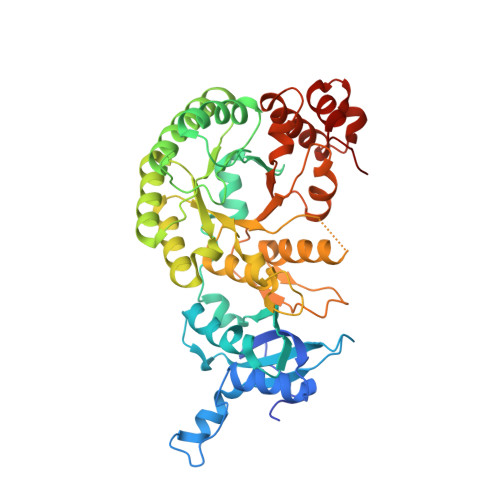Crystal Structure of a Novel-Type Archaeal Rubisco with Pentagonal Symmetry
Kitano, K., Maeda, N., Fukui, T., Atomi, H., Imanaka, T., Miki, K.(2001) Structure 9: 473-481
- PubMed: 11435112
- DOI: https://doi.org/10.1016/s0969-2126(01)00608-6
- Primary Citation of Related Structures:
1GEH - PubMed Abstract:
Ribulose 1,5-bisphosphate carboxylase/oxygenase (Rubisco) is the key enzyme of the Calvin-Benson cycle and catalyzes the primary reaction of CO2 fixation in plants, algae, and bacteria. Rubiscos have been so far classified into two types. Type I is composed of eight large subunits (L subunits) and eight small subunits (S subunits) with tetragonal symmetry (L8S8), but type II is usually composed only of two L subunits (L2). Recently, some genuinely active Rubiscos of unknown physiological function have been reported from archaea. The crystal structure of Rubisco from the hyperthermophilic archaeon Thermococcus kodakaraensis KOD1 (Tk-Rubisco) was determined at 2.8 A resolution. The enzyme is composed only of L subunits and showed a novel (L2)5 decameric structure. Compared to previously known type I enzymes, each L2 dimer is inclined approximately 16 degrees to form a toroid-shaped decamer with its unique L2-L2 interfaces. Differential scanning calorimetry (DSC), circular dichroism (CD), and gel permeation chromatography (GPC) showed that Tk-Rubisco maintains its secondary structure and decameric assembly even at high temperatures. The present study provides the first structure of an archaeal Rubisco, an unprecedented (L2)5 decamer. Biochemical studies indicate that Tk-Rubisco maintains its decameric structure at high temperatures. The structure is distinct from type I and type II Rubiscos and strongly supports that Tk-Rubisco should be classified as a novel type III Rubisco.
Organizational Affiliation:
Department of Chemistry, Graduate School of Science, Kyoto University, Sakyo-ku, 606-8502, Kyoto, Japan.















